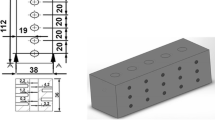Abstract
Due to the complexity of the tool and cutting geometry in machining, many undesirable effects occur during the cutting. Vibrations affecting the poor surface quality of the workpiece and the tool life are one of the most important undesirable effects. These vibrations causing loss of production should be detected and the most appropriate working conditions in which the machine tools will work more stable should be determined. In this work, an artificial neural network estimator has been designed in order to analyze the oscillating effects on computer numerical control (CNC) lathes. Firstly, experimental studies have been carried out, and then vibration analysis has been performed by using two types of artificial neural networks. The experimental part of this manuscript analyses has been carried out for the different material types, spindle speeds and feed rates which are affecting the vibration. After the experimental part, two different artificial neural network structures have been proposed in order to analyze the vibration data measured from the CNC lathe under the relevant working conditions. As a result of these experimental and simulation-based approaches, it was seen that the proposed RBNN structure has a good performance even in real-time parameters in capturing the vibrations occurring in the CNC lathe.



















Similar content being viewed by others
References
Siddhpura, M.; Paurobally, R.: A review of chatter vibration research in turning. Int. J. Mach. Tool Manuf. (2012). https://doi.org/10.1016/j.ijmachtools.2012.05.007
Catania, G.; Mancinelli, N.: Theoretical–experimental modeling of milling machines for the prediction of chatter vibration. Int. J. Mach. Tool Manuf. (2011). https://doi.org/10.1016/j.ijmachtools.2010.11.008
Alan, S.; Budak, E.; Özgüven, H.N.: Analytical prediction of part dynamics for machining stability analysis. Int. J. Autom. Technol. (2010). https://doi.org/10.20965/ijat.2010.p0259
Bharilya, R.K.; Malgaya, R.; Patidar, L.; Gurjar, R.K.; Jha, A.K.: Study of optimised process parameters in turning operation through force dynamometer on CNC machine. Mater. Today Proc. (2015). https://doi.org/10.1016/j.matpr.2015.07.268
Okonkwo, U.C.; Nwoke, O.N.; Okokpujie, I.P.: Comparative analysis of chatter vibration frequency in CNC turning of AISI 4340 alloy steel with different boundary conditions. J. Covenant Eng. Technol. 1(1), 13–27 (2018)
Powalka, B.; Dhupia, J.S.; Ulsoy, A.G.; Katz, R.: Identification of machining force model parameters from acceleration measurements. Int. J. Manuf. Res. 3(3), 265–284 (2008)
Hossain, M.S.; Chao, O.Z.; Ismail, Z.; Noroozi, S.; Khoo, S.Y.: Artificial neural networks for vibration based inverse parametric identifications. A review. Appl. Soft Comput. (2017). https://doi.org/10.1016/j.asoc.2016.12.014
Rao, K.V.; Murthy, P.B.G.S.N.: Modeling and Optimization of Tool Vibration and Surface Roughness in Boring of Steel Using RSM, ANN and SVM. J. Intell. Manuf (2018). https://doi.org/10.1007/s10845-016-1197-y
Mc, K.R.; Malghan, R.L.; Shettigar, A.K.; Rao, S.S.; Herbert, M.A.: Application of back propagation algorithms in neural network based identification responses of AISI 316 face milling cryogenic machining technique. Aust. J. Mech. Eng. (2020). https://doi.org/10.1080/14484846.2020.1740022
Ulas, H.B.; Ozkan, M.T.; Malkoc, Y.: Vibration prediction in drilling processes with HSS and carbide drill bit by means of artificial neural networks. Neural Comput. Appl. (2018). https://doi.org/10.1007/s00521-018-3379-3
Shrivastava, Y.; Singh, B.: Possible way to diminish the effect of chatter in CNC turning based on EMD and ANN approaches. Arab. J. Sci. Eng. (2018). https://doi.org/10.1007/s13369-017-2993-1
Ayaz, E.: Autoregressive modeling approach of vibration data for bearing fault diagnosis in electric motors. J. VibroEng. 16(5), 2130–2138 (2014)
Nandi, S.; Toliyat, H.; Li, X.: Condition monitoring and fault diagnosis of electrical motors—a review. IEEE Trans. Energy Convers. (2005). https://doi.org/10.1109/TEC.2005.847955
Khodja, A.Y.; Guersi, N.; Saadi, M.N.; Boutasseta, N.: Rolling element bearing fault diagnosis for rotating machinery using vibration spectrum imaging and convolutional neural networks. Int. J. Adv. Manuf. Technol. 106(5–6), 1737–1751 (2020)
Eski, İ.: Vibration analysis of drilling machine using proposed artificial neural network predictors. J. Mech. Sci. Technol. (2012). https://doi.org/10.1007/s12206-012-0813-9
Materka, A.; Strzelecki, M.: Parametric testing of mixed-signal circuits by ANN processing of transient responses. J. Electron Test. (1996). https://doi.org/10.1007/BF00137574
Esim, E.; Yıldırım, Ş.: Drilling performance analysis of drill column machine using proposed neural networks. Neural Comput. Appl. (2017). https://doi.org/10.1007/s00521-016-2322-8
Garg, S.; Pal, S.K.; Chakraborty, D.: Evaluation of the performance of backpropagation and radial basis function neural networks in predicting the drill flank wear. Neural Comput. Appl. (2007). https://doi.org/10.1007/s00521-006-0065-7
Li, B.; Chow, M.; Tipsuwan, Y.; Hung, J.: Neural-network-based motor rolling bearing fault diagnosis. IEEE Trans. Indust. Electron. (2000). https://doi.org/10.1109/41.873214
Pietrowski, W.: Application of radial basis neural network to diagnostics of induction motor stator faults using axial flux. Electric. Review 87(6), 190–192 (2011)
Altintas, Y.: Manufacturing Automation, 2nd edn. Cambridge University Press, Cambridge (2012)
Stephenson, D.A.; Agapiou, J.S.: Metal Cutting Theory and Practice. CRC Press, Boca Raton (2016)
Clough, R.W.; Penzien, J.: Dynamics of Structures. McGraw-Hill, New York (1993)
Rao, S.S.: Mechanical Vibrations Prentice. Hall, USA (2011)
Haykin, S.S.: Neural Networks and Learning Machines. Prentice Hall, New York (2009)
Yildirim, Ş.; Eski, İ.; Kalkat, M.: Force analysis of bearings on a modified mechanism using proposed recurrent hybrid neural networks. J. Mech. Sci. Technol. (2008). https://doi.org/10.1007/s12206-008-0415-8
Broomhead D. S.; Lowe D.: Complex system 2. In: Multivariable Functional Interpolation and Adaptive Networks, pp 568-576 Royal Signals and Radar Establishment Malvern, United Kingdom (1998)
Haykin, S.: Neural Networks A Comprehensive Foundation, 2nd edn. Prentice Hall, Upper Saddle River (2001)
Demuth H. B.; Beale M. H.; De Jess O.; Hagan M. T.: Neural network design (2nd ed.), Martin Hagan, eBook (2014)
Pano-Azucena, A.D.; Tlelo-Cuautle, E.; Tan, S.X.D.; De la Fraga, L.G.: FPGA-based implementation of a multilayer perceptron suitable for chaotic time series prediction. Technologies (2018). https://doi.org/10.3390/technologies6040090
Funding
This study has not been funded.
Author information
Authors and Affiliations
Corresponding author
Ethics declarations
Conflicts of interest
The authors declare that they have no conflict of interest.
Rights and permissions
About this article
Cite this article
Çetinkaya, M.B., Esim, E. & İşci, M. Analysis of the Vibration Characteristic of an Experimental Turning Lathe Using Artificial Neural Networks. Arab J Sci Eng 46, 2597–2611 (2021). https://doi.org/10.1007/s13369-020-05162-6
Received:
Accepted:
Published:
Issue Date:
DOI: https://doi.org/10.1007/s13369-020-05162-6




